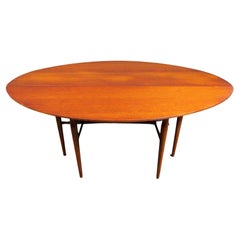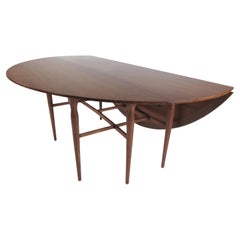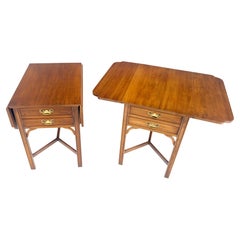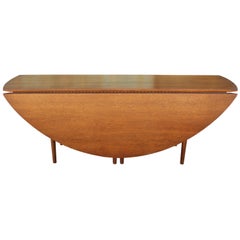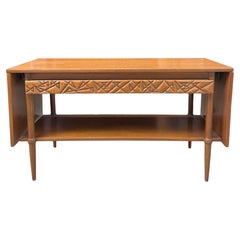Henredon Drop Leaf Table
20th Century Mid-Century Modern Drop-leaf and Pembroke Tables
Wood, Walnut
Vintage 1960s American Mid-Century Modern Drop-leaf and Pembroke Tables
Walnut
20th Century American Mid-Century Modern End Tables
Brass
Recent Sales
Vintage 1960s Mid-Century Modern Serving Tables
Mid-20th Century American Mid-Century Modern Console Tables
Wood
Vintage 1970s American Mid-Century Modern Dining Room Tables
Walnut
Vintage 1960s American Mid-Century Modern Drop-leaf and Pembroke Tables
Vintage 1960s American Mid-Century Modern Dining Room Tables
Wood
Mid-20th Century American Mid-Century Modern Dining Room Tables
Wood
20th Century American Mid-Century Modern Dining Room Tables
Walnut
Vintage 1950s American Mid-Century Modern Drop-leaf and Pembroke Tables
Walnut
Vintage 1950s American Mid-Century Modern Drop-leaf and Pembroke Tables
Walnut
People Also Browsed
Vintage 1950s Italian Mid-Century Modern Floor Mirrors and Full-Length M...
Brass
2010s Brazilian Modern Dining Room Chairs
Teak, Fabric, Upholstery
2010s Italian Renaissance Wall Mirrors
Glass
Vintage 1950s American Mid-Century Modern Credenzas
Wood, Walnut, Lacquer
Mid-20th Century Danish Mid-Century Modern Dining Room Chairs
Leather, Teak
Vintage 1970s Italian Mid-Century Modern Sofas
Fabric
21st Century and Contemporary Hollywood Regency Dining Room Chairs
Metal
Vintage 1930s Mid-Century Modern Coffee and Cocktail Tables
Birch
Mid-20th Century Modern Console Tables
Laminate
20th Century Danish Scandinavian Modern Dining Room Tables
Teak
Mid-20th Century Danish Scandinavian Modern Dining Room Tables
Brass
20th Century Mid-Century Modern Footstools
Chrome
Vintage 1970s Campaign Commodes and Chests of Drawers
Brass
21st Century and Contemporary Brazilian Modern Dining Room Tables
Steel
Vintage 1980s Italian Post-Modern Dining Room Tables
Steel
Mid-20th Century Italian Mid-Century Modern Floor Lamps
Marble
A Close Look at Mid-century-modern Furniture
Organically shaped, clean-lined and elegantly simple are three terms that well describe vintage mid-century modern furniture. The style, which emerged primarily in the years following World War II, is characterized by pieces that were conceived and made in an energetic, optimistic spirit by creators who believed that good design was an essential part of good living.
ORIGINS OF MID-CENTURY MODERN FURNITURE DESIGN
- Emerged during the mid-20th century
- Informed by European modernism, Bauhaus, International style, Scandinavian modernism and Frank Lloyd Wright’s architecture
- A heyday of innovation in postwar America
- Experimentation with new ideas, new materials and new forms flourished in Scandinavia, Italy, the former Czechoslovakia and elsewhere in Europe
CHARACTERISTICS OF MID-CENTURY MODERN FURNITURE DESIGN
- Simplicity, organic forms, clean lines
- A blend of neutral and bold Pop art colors
- Use of natural and man-made materials — alluring woods such as teak, rosewood and oak; steel, fiberglass and molded plywood
- Light-filled spaces with colorful upholstery
- Glass walls and an emphasis on the outdoors
- Promotion of functionality
MID-CENTURY MODERN FURNITURE DESIGNERS TO KNOW
- Charles and Ray Eames
- Eero Saarinen
- Milo Baughman
- Florence Knoll
- Harry Bertoia
- Isamu Noguchi
- George Nelson
- Danish modernists Hans Wegner and Arne Jacobsen, whose emphasis on natural materials and craftsmanship influenced American designers and vice versa
ICONIC MID-CENTURY MODERN FURNITURE DESIGNS
- Eames lounge chair
- Nelson daybed
- Florence Knoll sofa
- Egg chair
- Womb chair
- Noguchi coffee table
- Barcelona chair
VINTAGE MID-CENTURY MODERN FURNITURE ON 1STDIBS
The mid-century modern era saw leagues of postwar American architects and designers animated by new ideas and new technology. The lean, functionalist International-style architecture of Le Corbusier and Bauhaus eminences Ludwig Mies van der Rohe and Walter Gropius had been promoted in the United States during the 1930s by Philip Johnson and others. New building techniques, such as “post-and-beam” construction, allowed the International-style schemes to be realized on a small scale in open-plan houses with long walls of glass.
Materials developed for wartime use became available for domestic goods and were incorporated into mid-century modern furniture designs. Charles and Ray Eames and Eero Saarinen, who had experimented extensively with molded plywood, eagerly embraced fiberglass for pieces such as the La Chaise and the Womb chair, respectively.
Architect, writer and designer George Nelson created with his team shades for the Bubble lamp using a new translucent polymer skin and, as design director at Herman Miller, recruited the Eameses, Alexander Girard and others for projects at the legendary Michigan furniture manufacturer.
Harry Bertoia and Isamu Noguchi devised chairs and tables built of wire mesh and wire struts. Materials were repurposed too: The Danish-born designer Jens Risom created a line of chairs using surplus parachute straps for webbed seats and backrests.
The Risom lounge chair was among the first pieces of furniture commissioned and produced by celebrated manufacturer Knoll, a chief influencer in the rise of modern design in the United States, thanks to the work of Florence Knoll, the pioneering architect and designer who made the firm a leader in its field. The seating that Knoll created for office spaces — as well as pieces designed by Florence initially for commercial clients — soon became desirable for the home.
As the demand for casual, uncluttered furnishings grew, more mid-century furniture designers caught the spirit.
Classically oriented creators such as Edward Wormley, house designer for Dunbar Inc., offered such pieces as the sinuous Listen to Me chaise; the British expatriate T.H. Robsjohn-Gibbings switched gears, creating items such as the tiered, biomorphic Mesa table. There were Young Turks such as Paul McCobb, who designed holistic groups of sleek, blond wood furniture, and Milo Baughman, who espoused a West Coast aesthetic in minimalist teak dining tables and lushly upholstered chairs and sofas with angular steel frames.
Generations turn over, and mid-century modern remains arguably the most popular style going. As the collection of vintage mid-century modern chairs, dressers, coffee tables and other furniture for the living room, dining room, bedroom and elsewhere on 1stDibs demonstrates, this period saw one of the most delightful and dramatic flowerings of creativity in design history.
Finding the Right Tables for You
The right vintage, new or antique tables can help make any space in your home stand out.
Over the years, the variety of tables available to us, as well as our specific needs for said tables, has broadened. Today, with all manner of these must-have furnishings differing in shape, material and style, any dining room table can shine just as brightly as the guests who gather around it.
Remember, when shopping for a dining table, it must fit your dining area, and you need to account for space around the table too — think outside the box, as an oval dining table may work for tighter spaces. Alternatively, if you’ve got the room, a Regency-style dining table can elevate any formal occasion at mealtime.
Innovative furniture makers and designers have also redefined what a table can be. Whether it’s an unconventional Ping-Pong table, a brass side table to display your treasured collectibles or a Louis Vuitton steamer trunk to add an air of nostalgia to your loft, your table can say a lot about you.
The visionary work of French designer Xavier Lavergne, for example, includes tables that draw on the forms of celestial bodies as often as they do aquatic creatures or fossils. Elsewhere, Italian architect Gae Aulenti, who looked to Roman architecture in crafting her stately Jumbo coffee table, created clever glass-topped mobile coffee tables that move on bicycle tires or sculpted wood wheels for Fontana Arte.
Coffee and cocktail tables can serve as a room’s centerpiece with attention-grabbing details and colors. Glass varieties will keep your hardwood flooring and dazzling area rugs on display, while a marble or stone coffee table in a modern interior can showcase your prized art books and decorative objects. A unique vintage desk or writing table can bring sophistication and even a bit of spice to your work life.
No matter your desired form or function, a quality table for your living space is a sound investment. On 1stDibs, browse a collection of vintage, new and antique bedside tables, mid-century end tables and more .
- What is a drop-leaf table?1 Answer1stDibs ExpertSeptember 25, 2019
A drop-leaf table has a fixed section in the center and a hinged section, or leaf, on each side that can be folded down.
- How do I date a drop-leaf table?1 Answer1stDibs ExpertApril 5, 2022To date a drop-leaf table, first look for saw marks. If you see straight ones, your table likely dates back to before the early 19th century. Pieces made after should show curved saw marks. A licensed furniture appraiser can assist you with determining an exact date. Find a range of expertly vetted drop-leaf tables on 1stDibs.
- 1stDibs ExpertMay 5, 2023The first drop-leaf tables emerged during the era of the early 17th century. These first pieces usually feature a gate leg that swings out to support the leaf. Drop-leaf tables with side brackets debuted in the early 19th century. On 1stDibs, shop an assortment of drop-leaf tables.
- How does a drop leaf table work?1 Answer1stDibs ExpertAugust 24, 2021A drop-leaf table features a fixed section and one or more foldable sections. The well-made hinges hold the fixed and foldable sections and allow the leaves to pop up. These sections are anchored with the help of swing-out legs for secure placement. Find antique and vintage drop-leaf tables on 1stDibs.
- 1stDibs ExpertSeptember 28, 2021A drop-leaf table is a type of table that has a fixed portion in the center and foldable portions on either side joined by hinges. These foldable portions can be dropped and closed to save space when the table is not in use. On 1stDibs, find a variety of antique and vintage drop leaf dining tables.
- 1stDibs ExpertFebruary 13, 2023While you can look for markings and other details to try and determine the maker, the best way to identify an antique drop leaf table is to work with a certified appraiser. Trusted online venues and search engines can be helpful when conducting research on a specific collectible, piece of jewelry, art work or other item about which you may have questions, but qualified professionals, such as an antiques dealer or an appraiser at an auction house, have the knowledge and experience needed to make more accurate identifications. Shop a selection of antique, vintage and modern tables on 1stDibs.
- 1stDibs ExpertNovember 20, 2024To tell how old your drop leaf table is, first see if it bears a maker's mark. Looking up this marking using trusted online resources can enable you to identify the maker. From there, you can conduct further research to determine when it was in business and crafting tables like yours. For unmarked tables, it is generally necessary to become familiar with the various styles of drop leaf tables, such as the 17th-century Gateleg table, recognizable by the stretchers that connect its legs, and the 18th-century Pembroke table, which typically has two drawers. However, contemporary reproductions of these types of tables exist, making it difficult to date pieces without training and experience. As a result, you may wish to use the services of a certified appraiser or experienced antique dealer. On 1stDibs, explore an assortment of drop leaf tables.
- 1stDibs ExpertFebruary 17, 2023The difference between a gateleg table and a drop leaf table is the design of the section that you can raise to expand the piece. On a drop leaf table, the extension does not have any lower support. A gateleg table has a leg that swings out to rest beneath the extension. Find a selection of tables from some of the world's best sellers on 1stDibs.
Read More
The Ultimate Guide to Types of Tables for the Home
Whether you’re just moving in or ready to give your home a makeover, our guide will give you pointers on tables that are fitting for every room, nook and hallway.
May’s Most Popular Interiors on Instagram
Our feed is filled with the world's most beautiful spaces. See the rooms our followers have deemed the best of the best this month.
New Orleans’ Lee Ledbetter Makes Design Magic by Mixing Past and Present
The Louisiana-born and -bred architect talks to 1stdibs about the art of making timeless places that matter.
Desert Modern Designer Arthur Elrod Finally Gets His Day in the Sun
The Palm Springs interior decorator developed a mid-century style that defined the vacation homes of celebrities and other notables, including Bob Hope and Lucille Ball.
From the Hamptons to Palm Springs, FormArch’s Homes Embody Both Comfort and Cool
The houses from this New York studio cloak modernist tendencies within what are often more traditional trappings.
